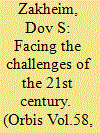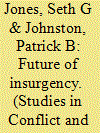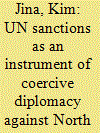|
|
|
Sort Order |
|
|
|
Items / Page
|
|
|
|
|
|
|
| Srl | Item |
| 1 |
ID:
126752


|
|
|
|
|
| Publication |
2013.
|
| Summary/Abstract |
America's strategy has become increasingly budget-driven in the face of ongoing cuts, culminating in the sequester. As a result, fewer funds are, and will be, available for critical operations, notably exercises and training with foreign forces that are the key both to strengthening alliances and partnerships and to deterring current and potential adversaries. That Washington continues to revise its defense strategy virtually on an annual basis has further undermined its credibility worldwide. Given its long-standing global interests, and uncertainty regarding when and where it might again have to commit forces to defend them, the United States must reinvigorate its efforts to streamline the Defense Department so as to maintain its global posture in the face of budget pressures. Measures to improve defense efficiency include reductions in the civilian and contractor work forces, overhaul of the military medical and retirement systems, and repeal of anachronistic laws that foster waste in defense acquisition.
|
|
|
|
|
|
|
|
|
|
|
|
|
|
|
|
| 2 |
ID:
120427


|
|
|
|
|
| Publication |
2013.
|
| Summary/Abstract |
What are key historical trends in insurgencies? And what do these finding suggest about the future of insurgency? We examine four aspects: causes of insurgency, outside support, strategies, and tactics. Based on an examination of quantitative and qualitative data, we make several arguments about the future. China could become increasingly involved in supporting insurgencies and counterinsurgencies if its economic and military power continues to increase and its global interest expands. In addition, insurgent groups will likely require less time to achieve high levels of sophistication for improvised explosive devices and other asymmetric tactics, which we expect they will use against more powerful mechanized counterinsurgent forces. We also expect that insurgent groups may take advantage of commercially-available technology to communicate, distribute propaganda, and recruit individuals. In addition, insurgents will likely make further use of encryption, anonymizing services, location-masking tools, and other related technologies to protect their online activities.
|
|
|
|
|
|
|
|
|
|
|
|
|
|
|
|
| 3 |
ID:
134078


|
|
|
|
|
| Publication |
2014.
|
| Summary/Abstract |
North Korea has recently been subject to a greater amount of pressure than ever, but there is a gap between the desired outcome and reality. Hence, this study aims to examine the effectiveness of the international sanctions on North Korea and conditions that help coercive measures work successfully. It explores how coercive diplomacy operates and how well it works, how UNSC resolutions have developed and how compliant UN member states are with those resolutions based on an examination of country reports submitted to the UN Sanctions Committee. Although the UNSC resolutions carry ascending enforcement power and expanded the scope of actions and strengthened enforcement measures, there is asymmetry in interest and capacity of UN member states and implementation has been uneven globally. Hence, this study presents policy implications and suggestions for successful sanctions on North Korea.
|
|
|
|
|
|
|
|
|
|
|
|
|
|
|
|
|
|
|
|
|